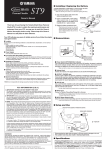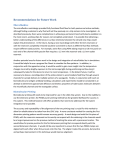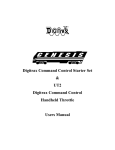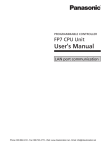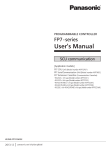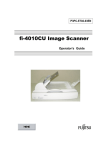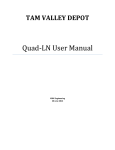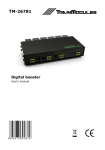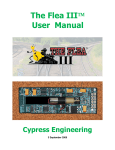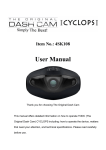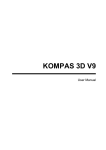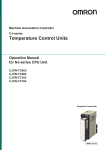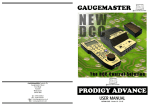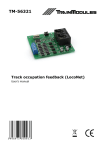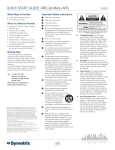Download Instruction Manual
Transcript
TM 1.0 Overview RADIO EQUIPPED The DT100R is a Digitrax factory upgraded version of the DT100 throttle that is capable of “tetherless” or radio operation on a correctly configured LocoNet system. The design of the DT100R takes advantage of the capabilities of the LocoNet network architecture to allow cost-effective upgrades to multiple throttles that can be operated simultaneously on the same LocoNet network. DT100R & UR91 Installation & Users Manual Table of Contents Page # 1.0 Overview 2.0 DT100R Installation 3.0 UR91 Installation 4.0 Operation of DT100R on a LocoNet 4.1 LocoNet Connection 4.2 Display power down 4.3 LocoNet ID change 4.4 Locomotive release 4.5 Radio Override 5.0 Regulatory-FCC Information 6.0 Warranty & Repair Information 2 3 4 6 6 7 7 8 8 8 9 When used in the tethered mode, connected by a cable to LocoNet, the DT100R behaves exactly as a regular DT100 and has exactly the same features and capabilities. This user manual is a supplement that just covers the extra capabilities the DT100R has. Please refer to your DT100 manual for operation of regular DT100 features. The DT100R has no user serviceable parts. The Radio Frequency circuitry is Digitrax factory installed and is FCC Certified to operate in the US 32cm ISM band. This band allows convenient unlicensed operation with the greatest maximum allowed transmit power for high speed data transfer in a model railroad control use. For convenience of use the antenna is wholly contained inside the case of the DT100R. The DT100R's short LocoNet cable is not used for and does not affect unit's RF or radio performance. This LocoNet cable is solely used by the DT100R for system configuration and Locomotive selection. The short cable also allows a DT100R to visit other layouts and be hosted on another LocoNet system that may not be Radio capable. The DT100R is the first element of a series of Digitrax products that are aimed at allowing the convenience of “cordless” walkaround throttle capability. To create a working system a UR91 or similar RF LocoNet interface must be installed on the LocoNet system. A single UR91 RF network interface can simultaneously support up to about ten or more DT100R’s within an approximate 200 ft diameter service area. Other connected and tethered throttles such as the DT200, BT2, and UT1’s etc. do not affect the DT100R operations, range or capacities. The actual range in any particular layout room will vary depending on the physical layout and room construction. The distributed intelligence and event driven network capability of LocoNet allows multiple UR91’s to cooperate efficiently on a single LocoNet. This allows overlapping service 2 areas, increased service coverage and increased reliability from space diversity. This is similar to the way radio towers are used to expand cellular telephone coverage. The aim of the DT100R and UR91 pair is intermediate range and low-cost walkaround throttle and controller solutions for home and club layouts. To allow lowest cost, the DT100R operates as a simplex or one-way transmitter and uses its cable connection to establish initial locomotive address selection. After a DT100R has selected a locomotive, it may then be untethered and will automatically revert to radio operation for all subsequent, speed, direction, function and turnout commands. A DT100R can release a locomotive and power the layout on and off whilst untethered. As with any sensible locomotive operations, even the prototypes!, it is recommended that the engineer pay attention to his train movements and be aware of the location and state of the units under his care. The DT100R will operate with normal 9V Alkaline cells and will also operate with either 9V or 7.2V rechargeable NiCad batteries. Normal usage will give typically 20 or more hours of tetherless operations on a fresh battery. When the DT100R is connected to a powered LocoNet it will not use its RF section and can draw all its power requirements from the network. Note that the DT100R and UR91 are RF products and may only be used in countries that these units have been tested for and Certified or Type Approved for sale and operation. Use in areas that have not been given approval may result in interference to other critical radio services and substantial penalties. Please see Regulatory section later in this manual for specifics. 2.0 DT100R Installation There is no installation required for a DT100R. The LocoNet that it is to operate on will need to have an installed and operating UR91 unit to enable tetherless operations. To operate the radio capability the DT100R will need a battery installed with correct polarity and at least 6.0V to 9.6V terminal voltage. See the UR91 instructions for setup and testing information. There are no user adjustments to the DT100R. 3 3.0 UR91 Installation When the UR91 is being added to a LocoNet system it is a good procedure to perform a quick survey of the operating area to check reception and performance. Performance Check: To verify correct system operation we recommend simple testing similar to that outlined here. Unpack the UR91 and unbend vertically its two small flexible antennas at the rear . Spread the 2 antennas about 20 degrees apart. If the system supports more than 3 tethered throttles we recommend powering the UR91 via the extra 2.0mm +12V DC power jack on the side. Connect the system’s LocoNet cable to one of the rear LocoNet 6 pin connectors. You may “daisy chain” the LocoNet backbone wiring through the UR91. Always remember to site sufficient LocoNet plug-in jacks around the layout to allow concurrent operations of tethered throttles. This also allows operators/engineers the choice to reconnect conveniently if for example they feel they have no control due to low battery power etc. 1) Temporarily install the UR91 on the LocoNet at a central location that will likely provide best coverage within a roughly 200’ diameter circle. Remove all loco’s from the layout and power up the layout and track. The Green LED on the UR91 should be lit indicating the UR91 has passed it internal self-tests and is ready to receive RF wireless data. 2) Connect the DT100R to the LocoNet with its cord and select loco address “00” for the analog loco. Select the analog loco speed to 99% or full speed. Connect a bi-color LED indicator lamp across powered track. The bicolor resistor led supplied with the Digitrax test kit is ideal for this. For extra convenience, consider adding alligator clips to the leads. Change the direction of the address “00” loco and confirm that the LED changes color from mainly green to mainly red and vice-versa. This confirms we are communicating with the system and the LED color reversal will be used as a convenient indicator when we unplug and change to radio operation. 3) Unplug the DT100R and move about the service area, changing the direction of address “00” and watching the LED indicator to verify the system responds correctly. It is good practice to walk around the whole service area to see if any RF “blind spots” may exist. Move the bicolor LED 4 as needed to maintain visibility. Slowly rotate in place at each test spot to check reception for various directions. Most installations will show good reception and you may now continue to operate the system by affixing the UR91 in its final location. You should now be able to enjoy the benefits of untethered radio operations! 4) With a Chief based LocoNet, it may be easier to temporarily set the DCS100 Option Switch #41 to closed. This will make the DCS100 give a diagnostic “click” each time it receives a good LocoNet message. The red DCS100 “NET” led will also blink for a good LocoNet message seen. The sound indication may be easier to pick up in a larger layout area where the DCS100 may not be in view. . 5) You could substitute a real Analog locomotive at address “00” instead of the indicator bicolor LED. Just keep the speed of the locomotive low so that if you appear to lose control you have time to react and plug back in the system. A digital decoder equipped loco may also be used by selecting the correct address when the DT100R is plugged in. Resolving coverage issues: If you are not satisfied with the test reception, follow the steps in this section. a) In some installations, wiring, metal plumbing and A/C ducting and other items may cause small areas of poor reception around the layout. This is typically due to the multipath reflections or echoes of the radio waves. With the UR91 these areas will be fairly limited within the service area or most typically may not exist. Moving about 6” to 12” in any direction or varying the orientation of the DT100R will typically overcome any dropouts. Finding a more central or different reception location for the UR91 may also allow the coverage pattern to be modified to be acceptable. The best orientation to hold the DT100R in normal usage is about from about horizontal to 30 degrees upwards in a natural hand position about 12” out from your body. This gives best coverage and may help in a marginal area. spread about 20 degrees apart is a good compromise for most areas and coverage. Be sure not to bend the copper antenna wires too many times as this could lead to fracture. Changing the UR91 antennas will not lead to improved performance. Do not allow the UR91 antennas to connect to bare conductors or layout wiring. It is good practice to keep other wires below the antenna level and about 1-2 feet away from them. c) If adjustment of UR91 location and antennas does not clear a stubborn dead spot or range problem consider adding a second UR91 spaced out to give good coverage to the problem area. This is the use of “space diversity”. The UR91’s are intelligent LocoNet agents and numerous units may be present on the same LocoNet system. They automatically co-operate over the LocoNet and you need perform no other action except plug in extra UR91’s if they are beneficial. Note that the majority of layouts will work well with a single UR91. d) Note that the DT100R shares the radio spectrum with other types of radio services and might sometimes experience transient interference. If interference persists then consider using the DT100R’s in the tethered mode until the problem clears. You may turn off the DT100R radio option by modifying the Secondary Option code when first powering up with a battery. See the setup section. The modest range of the UR91 and the screening effect of most layout rooms provide some buffer from interference. 4.0 Operation of DT100R on a LocoNet When a DT100R is plugged into a working Loconet, it will verify that at least one UR91 is present and is at the correct band and frequency to allow successful operation. The DT100R will then assume the current Network ID that the UR91(s) are set to, and subsequently allow itself to revert to radio operation when it detects LocoNet disconnection. 4.1 LocoNet Connection b) The small antennas on the UR91 may be adjusted from the natural vertical “V” orientation to horizontal towards the UR91 rear, in some installations. This allows stronger reception of horizontal polarisation that may be experienced in some cases, eg. in buildings with metal floors and roofs. It is best to evaluate each layout and adjust the system for best reception. It is hard to exactly predict the performance for any “typical” layout and surroundings. The UR91 antennas being nearly vertical and 5 On connection the DT100R LCD display will flash the radio status code “rA:0n” where the number “n” signifies the LocoNet ID being used by all UR91’s on the system it has plugged into and will be identifying itself with. The display will then revert to normal DT100 tethered operation displays and actions. If the system does not have a UR91 or equivalent device, the DT100R display will flash up “r-:--” to show that it cannot operate 6 tetherless on that system and thus not allow the radio to be active when untethered. If an untethered DT100R with active throttles is plugged into a LocoNet with a different LocoNet ID than it is currently using, it will immediately clear its throttle settings and send no RF indication it has released any active throttles. 4.2 Display power down When the DT100R has connected to a LocoNet and received the LocoNet ID number it will allow tetherless operation of locomotives that have been selected into either throttle knob. If an untethered DT100R detects no user throttle activity for more than about 1 minute it will the enter power or battery conserve mode and display on the LCD the radio status code “rA:0n” until a throttle or key action restores normal activity and displays. 4.3 LocoNet ID change In normal operations a DT100R will accept and use the LocoNet ID offered by the UR91(s) it may see when connected to the network. To allow a LocoNet to be changed to a different ID number, to allow for example 2 clubs to have layouts at the same show, the DT100R may be used to change the LocoNet ID number of one of the independent LocoNet systems. To change a LocoNet ID number: 1) Disconnect a DT100R (with a battery in it) from the LocoNet that you wish to modify the ID of. 2) Press and hold down the MODE/DISP key on the DT100R and then reconnect the unit to the LocoNet. This key being active upon reconnect enables the DT100R to be allowed to modify the system ID. 3) Release the MODE/DISP key. The DT100R will flash up the current radio status “rA:0n”, where the “n” digit shows the current LocoNet ID. Use RIGHT HAND THROTTLE to change the ID digit “n” to that desired, in the range 0 to 7, and then press the SEL/SET key to set the system to the new ID. 4) Be sure to reconnect any DT100R that is going to be used on this system back to the system so it can adopt the new ID number and be able to access the new system ID. 7 If you add a new UR91 to the system and are using a LocoNet ID other than the default value of 0, you need to resynchronize the ID's in all the UR91's following the outlined steps above with a new ID for the whole system 4.4 Locomotive release When working untethered with an active throttle in the LCD display, if the SEL/SET key is pressed the locomotive address will immediately be released as common in the system and that throttle will become inactive. To reselect this locomotive you will then need to reconnect to the LocoNet and reselect it. 4.5 Radio Override A value of "43" entered as the Secondary Option for a DT100R will disable the RF option. A value of "03" will re-enable the RF or radio option. This may be changed any time new batteries are installed and the DT100R initialized. 5.0 Regulatory-FCC Information Radio or TV Interference: (this information is MANDATED by the FCC) This equipment has been tested and found to comply with the limits for a Class B digital device, pursuant to part 15 of the FCC rules. These limits are designed to provide reasonable protection against harmful interference in a residential environment. This equipment generates, uses and can radiate radio frequency energy and, if not installed and used in accordance with the instruction manual, may cause harmful interference to radio communications. However, there is no guarantee that interference will not occur in a particular installation. If this equipment does cause harmful interference to radio or television reception, which can be determined by turning the equipment off and on, the user is encouraged to try to correct the interference by one or more of the following measures: -Reorient or relocate the receiving antenna. -Increase the separation between the equipment and the receiver. -Connect the equipment into an outlet on a circuit different form that to which the receiver is connected. -Consult the dealer or an experienced radio/TV technician for help. Note that any modifications to the equipment not expressly approved by Digitrax voids the user's authority to operate under and be in compliance with CFR 47 rules, as administered by the Federal Communication 8 Commission. Digitrax believes any conscientiously installed equipment following guidelines in this manual would be unlikely to experience RFI problems. For Canadian Users: "This digital apparatus does not exceed the Class B limits for Radio noise emission from digital apparatus set out in the Radio Interference Regulation or the Canadian Department of Communications." Le present appariel numerique n emet pas de bruits radio-electriques depassant les limites applicables aux appareils numeriques de la classe B prescrites dans le Reglement sur le brouillage radioelectrique edicte par le ministere des Communications du Canada. The ISM band used by the DT100R also supports other forms of data networks, telephones, remote video cameras and other radio devices. The DT100R encoding is redundant at several levels and chosen to minimise interruption from other possible interfering co-channel devices. The low man-made noise of this band and typically short range nature of most devices at this frequency allow the DT100R and UR91 to perform well in most areas. The DT100R is certified for “unlicensed” operations within the United States by the US FCC and has the identifier. FCC ID: LV3DT100R. started the installation. In the event that you somehow manage to "blowup" one of these little guys, we will repair or replace it for a nominal fee (call for the current amount) if you return the decoder to us. Do not remove the shrink-wrap protective sleeves from Digitrax decoders or open the Command Stations or other products. None of the units have user serviceable parts, & opening them will void ALL warranty protection. If you are returning a decoder that failed the test procedure, all wires must be their original lengths. Do not cut any wires or install any units until you are sure they have passed the Decoder Test Procedure detailed in the Decoder Manual. Please don't return anything to Digitrax without calling & getting return instructions. In order to make sure we give you the best service possible, please call (770) 441-7992 to let us know before you send anything to us for service or as a return. All warranties on Digitrax products are limited to refund of purchase price or repair or replacement of Digitrax products at the sole discretion of Digitrax. In the event that Digitrax products are not installed or used in accordance with the manufacturer's specifications, any & all warranties either expressed or implied are void. Except to the extent expressly stated in this section, there are no warranties, express or implied, including but not limited to any warranties of merchantability or fitness for a particular purpose. 6.0 Warranty & Repair Information DT100R One year guarantee on DT100R. These units are not user serviceable. If a defect occurs, return the unit to us for service. We will repair or replace these units at our discretion at no charge to you for one year from purchase date. This warranty excludes damage due to abuse, such as failure to properly protect against input over current with a fuse or circuit breaker or applying excessive input voltage to the unit. We will make any repair needed because of physical damage or electrical abuse at fair & reasonable rates. Decoders Digitrax carefully tests every decoder we ship to be sure that you receive reliable products. Because we want you to be comfortable installing your own decoders, we outline a decoder test procedure that you can perform so that you can be sure your decoder works before you begin installing it in your locomotive. If, within 60 days of purchase, your decoder fails to pass the decoder test procedure outlined in the instructions, we will replace it free of charge to you. Because we can't control the actual decoder installation we can't cover your decoder once you have tested it & 9 10






